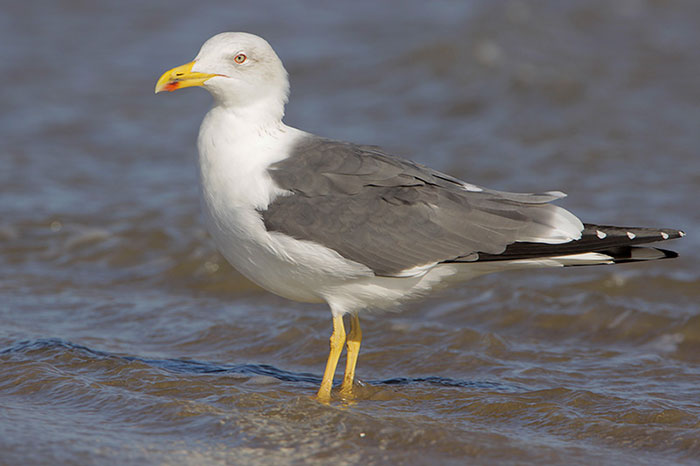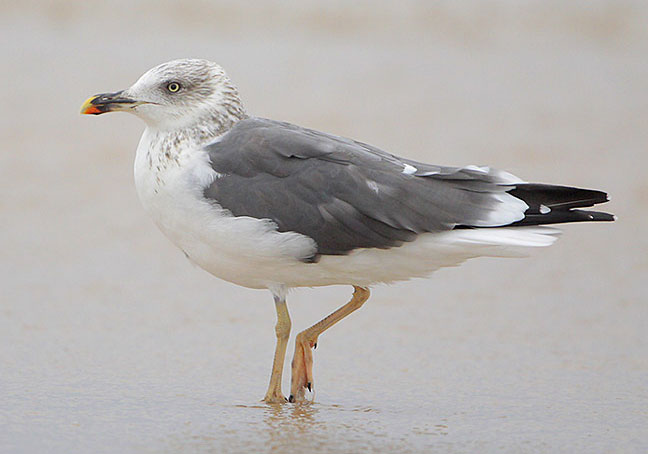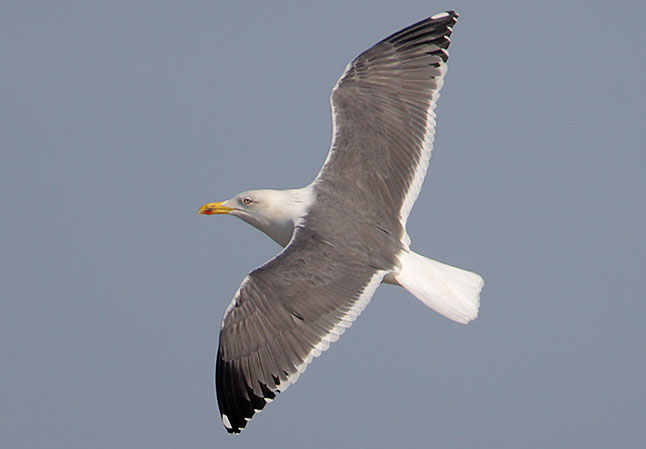Primarily a gull of the Western Palearctic, the Lesser Black-backed Gull is rare to uncommon in winter along the East and Gulf Coasts of North America, and at scattered locations inland. Most North American Lesser Black-backed Gulls probably come from the closest breeding population in Iceland.
Similar in size to the Herring Gull, the Lesser Black-backed Gull differs in having much darker upperparts, and yellow rather than pink legs. It has become much more common in North America in the past two decades than it was previously.
On this page
Description of the Lesser Black-backed Gull
BREEDING MALE

Photograph © Greg Lavaty
The Lesser Black-backed Gull is a large gull with plumage that varies somewhat by age and by season. Breeding adults have white heads and a yellow bill with a red spot near the tip. A white foreneck neck and underparts contrast with dark gray upperparts. In flight, the primaries are extensively black with a small white spot. The legs are yellow.
Female
The sexes are similar.
Seasonal change in appearance
Winter adults have brown streaking on the head and nape.
Juvenile
Immature birds are mostly brown, with a mostly dark bill. They attain adult plumage by age four.
Habitat
Lesser Black-backed Gulls inhabit coastal areas, lakes, and landfills.

Photograph © Greg Lavaty
Diet
Lesser Black-backed Gulls eat fish, garbage, clams, crabs, worms, berries, and eggs.
Behavior
Lesser Black-backed Gulls forage by walking or swimming, and sometimes by swooping down to the water’s surface.
Range
Lesser Black-backed Gulls are European in origin, but now occur regularly in winter along the Atlantic and Gulf coasts, and occasionally inland. The population is increasing.
Fun Facts
Formerly rare in the U.S., Lesser Black-backed Gulls are now fairly common in winter.
Lesser Black-backed Gulls often occur with Herring Gulls.
Vocalizations
The voice is a nasal bugle.
Similar Species
- Immature Herring Gulls are larger and have larger bills. Adult Lesser Black-backed Gulls have a darker mantle than adult Herring Gulls.
Nesting
The Lesser Black-backed Gull’s nest is a mound of plant material on the ground or on a cliff ledge.
Number: Usually lay 3 eggs.
Color: Brownish or olive with darker markings.
Incubation and fledging:
The young hatch at about 24-27 days, and leave the nest within a few days, though they cannot fly for about 35 days and they associate with the adults for some time
Bent Life History of the Lesser Black-backed Gull
Published by the Smithsonian Institution between the 1920s and the 1950s, the Bent life history series of monographs provide an often colorful description of the birds of North America. Arthur Cleveland Bent was the lead author for the series. The Bent series is a great resource and often includes quotes from early American Ornithologists, including Audubon, Townsend, Wilson, Sutton and many others.
Bent Life History for the Lesser Black-backed Gull – the common name and sub-species reflect the nomenclature in use at the time the description was written.
BRITISH LESSER BLACK-BACKED GULL
LARUS FUSCUS AFFINIS (Reinhardt)HABITS
The Siberian gull is no longer entitled to a place on our list, which it has held ever since the type specimen of Larus affinis was taken in Greenland and described by Reinhardt. The lesser black-backed gull of Europe and Asia has been subdivided into three subspeciesó Larus fuscus fuscus Linnaeus of northern Europe, Scandinavia, etc.; Larus fuscus affinis Reinhardt of the British Isles, Faroes, and Greenland; and Larus fuscus antelius Iredale of Siberia. Reinhardt’s bird, the type of Larus aflinis and the bird which occurs as a straggler in Greenland was, until recently, supposed to be of the Siberian form. But Iredale has recently examined Reinhardt’s type specimen and found it to be referable to the British form, the wellknown lesser black-backed gull. He therefore gave a new name to the Siberian form, which necessitated the above rearrangement of the group, and makes it necessary for us to eliminate the Siberian gull from our list and enter in place of it the British lesser blackbacked gull (Larus fuscus affinis iReinhardt).
Nesting: This well-known gull occurs in Great Britain, both as migrant and as a resident, through out the year. Much has been written about its habits. Dr. Henry 0. Forbes (1898) writes of its breeding habits:
In May the lesser black-backed gulls select their nestlng place, betaking themselves, as Macgilllvray states, “to unfrequented islands, headlands, and sometimes Inland lakes (and mosses), often in considerable numbers, and there remain until their young are able to fly, although they make extensive excursions around in search of food.” On the Teifi Bog, in mid-Wales, about 12 miles from the sea, the nests are placed on slight hillocks, generally in deep heather, the vicinity, with trampled grass and scattered feathers, being suggestive of a goose green” (Salter). “In Hoy (in the Orkneys) anyone,” writes Mr. Moodie-Heddle to Harvie-Brown, “can create a breeding place of the lesser black-backed gull by burning a large tract late in the season; the gulls then come on the bare ground (through the following summer and autumn) to catch moths and winged insects, which have no heather left to go down Into. They then usually begin to breed on the tufts of white moss left unburut the following season. The breeding places by the water of Hoy and down to Pegni Burn were thus formed by accidental fires. No gulls bred there for many years before, and we could kill 60 to 70 brace more grouse.
In Iona, Mr. Graham notes that this gull made its nest on the flat, marshy summits of all the lesser islands. The nest is sometimes on the bare rock, but more often on a grassy slope, if such exist near. The most remarkable situation for a nest, perhaps, is that cited by Doctor Sliarpe, which was placed In the middle of a sheep track, and the sheep, in passing to and fro, had to jump over the back of the sitting bird. This nest (with its four eggs) is now in the British Museum.
This species breeds In colonies, which in some places arc very large, when their nests are placed so close to each other, that it is by no means easy to traverse their nursery without treading upon either the eggs or young. The nest, if on the ground, is little more than a scraped out hoilow in the ground, lined with grass, seaweed, or herhage of any kind within reach; if on a rock, a larger pile of the same substances Is built up in the selected niche or ledge. It is not at all uncommon to find the herring gull nesting in close proximity to it, only, however, in the more inaccessible ledges or summits. Three eggs are laid as a rule – four occasionally, sometimes only two – which vary very greatly In size, shape, and color. Many of them are hardly, if ever certainly, to be distinguished from those of the herring guil. They vary in size from 21 to 8 inches in length, by 1* to 2 in diameter. Ground color, from very pale gray, through olive-brown to greenish-blue or chocolate-brown, spotted and blotched, often more abundantly at tile greater end, with black or dark brown. From the end of May, through June and into July, eggs and chicks of all stages and ages may be found.
Eggs: Rev. F. C. R. Jourdain has sent me the following measurements of eggs of this gull from the British Isles: Eighty eggs average 68.04 by 47.39 millimeters; the eggs showing the four extremes measure 77.1 by 49, 72.5 by 52.1, 58.6 by 45 and 61.3 by 43 millimeters.
Young: Doctor Forbes (1898) says of the young:
After about three weeks’ incubation the chicks break through their prison, as lively and nimble balls of down, grayish-buff above, with the head, neck, and back spotted with brown; the under side paler and unspotted. On the least Intrusion on their cubicle tney are ready to be offórunning, as Mr. Rattye remarks, head down and shoulders up like a falconóto the nearest herbage or water for security; but if left undisturbed they may be found for a fortnight or more ill the nest, most assiduously tended by the parents. The approach of any Intruder when the helpless young are In the nests is the signal to set the whole of the colony on wing, wheeling round his head, swooping down upon and screaming at him.
Plumages: When fledged, the bill, legs, and feet are livid corneous. The feathers, which are white in the adult, have a center streak, or a bar of ashybrown, and pale edges; and where black they are reddish-brown, with yellowishwhite edges. Tile wing feathers are sooty or black, and the tail is mottled wIth brown, which, near the end, becomes almost a continuous bar, the tips of the feathers being grayish-white; the bill is horn color, and the legs and feet brownIsh-white.
During its first autumn the bird undergoes no true molt, but the brown becomes less marked in some parts by loss of pigment, and more uniform through the wearing off of the pale tips. In the next spring there Is a more general but slow molt, in which the brown comes in of a less deep shade, and during the second autumn its color becoxncs a little paler still. During the next year, in spring and autumn by feather-changes, and loss of pigment in them, the brown is still further lost; bill yellow at Its base, but without the red spot on the angle of the mandible.
In the fourth autumn this gull has assumed almost the complete winter dress of the adult – the white spot near the end of the primaries perhaps alone not being well marked. The following spring, when the bIrd is in its fifth year, sees it in its first nuptial plumage. As soon as that interesting period is over the gull begins to assume Its first mature winter garb, which differs only from that of the summer in showing brown streaks on the head and neck.
Behavior: Macgillivray (1852) writes:
The flight of this bird is peculiarly elegant, resembling, however, that of the greater black-backed gull, but more easy and buoyant, with the wings considerably curved. Its ordinary cry is loud, mellow, and somewhat plaintive, and when a number join in emitting it, which they sometimes do, when assembled for repose on an unfrequented beach or Island, may be heard at a great distance and Is then far from being unpleasant. It also emits occasionally a cackling or laughing cry, more mellow than that of the species above named. It searches for food on the open sea, in estuaries, on the beaches, and frequently on the land, sometimes flying to a great distance from the coast. Small fishes, crustacen, echini, shellfish, land mollusca, and earthworms are its habitual food, but It also eats of stranded fishes and devours young birds. When shoals of young herrings are In the bays, creeks, or estuaries it may often be seen in great numbers, intermingled with other gulls; but when reposing, whether on the sea or on land, It generally keeps separate In small flocks.
Doctor Forbes (1898) adds the following:
Mr. Thompson notes that this gull is very fond of ascending rivers, as well as visiting inland lakes. Several of these birds may be seen, in winter and spring, in the river Lagan as far as the first fall above the sea, where the canal commences, the snowy whiteness and pure black of their plumage contrasting finely with the background of dark foliage of the river banks. On one occasion [continues the same naturalist] I observed an adult bird fishing * * * high up the Lagan, * while soon afterwards two immature birds flew up the course of the river until they joined him. They were no doubt the bearers of some particular intelligence, as Immediately on their reaching the old bird he wheeled about and the three proceeded with their utmost speed down the river. In like manner I once observed several of the black-headed gulls feeding in a ploughed field, half a mile from the shore of the bay, whence a single bird flew direct to them; the moment it arrived they all wheeled about, and, with their best speed, made for the bay, where It was low water at the time. They were not in any way alarmed In the field; the courier seemed to convey some special news.
DISTRIBUTION
Breeding range: The British Isles from the Faroes to the Channel Islands, on the coasts of France and probably Spain; south to Alboran Island off Morocco. From the Scandinavian Peninsula eastward it is represented by another subspecies.
Winter range: From the British Isles south to the western Mediterranean, the Canary and Madeira Islands, and the west coast of Africa.
Casual records: The type specimen was taken in Greenland, whieb is the only North American record.


